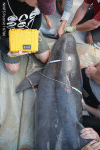Health Assessments of Common Bottlenose Dolphins (Tursiops truncatus): Past, Present, and Potential Conservation Applications
- PMID: 31921905
- PMCID: PMC6923228
- DOI: 10.3389/fvets.2019.00444
Health Assessments of Common Bottlenose Dolphins (Tursiops truncatus): Past, Present, and Potential Conservation Applications
Abstract
The common bottlenose dolphin (Tursiops truncatus) is a global marine mammal species for which some populations, due to their coastal accessibility, have been monitored diligently by scientists for decades. Health assessment examinations have developed a comprehensive knowledge base of dolphin biology, population structure, and environmental or anthropogenic stressors affecting their dynamics. Bottlenose dolphin health assessments initially started as stock assessments prior to acquisition. Over the last four decades, health assessments have evolved into essential conservation management tools of free-ranging dolphin populations. Baseline data enable comparison of stressors between geographic locations and associated changes in individual and population health status. In addition, long-term monitoring provides opportunities for insights into population shifts over time, with retrospective application of novel diagnostic tests on archived samples. Expanding scientific knowledge enables effective long-term conservation management strategies by facilitating informed decision making and improving social understanding of the anthropogenic effects. The ability to use bottlenose dolphins as a model for studying marine mammal health has been pivotal in our understanding of anthropogenic effects on multiple marine mammal species. Future studies aim to build on current knowledge to influence management decisions and species conservation. This paper reviews the historical approaches to dolphin health assessments, present day achievements, and development of future conservation goals.
Keywords: Tursiops truncatus; conservation; dolphin; health assessment; veterinary medicine.
Copyright © 2019 Barratclough, Wells, Schwacke, Rowles, Gomez, Fauquier, Sweeney, Townsend, Hansen, Zolman, Balmer and Smith.
Figures







References
-
- Gulland FMD, Hall AJ. Is marine mammal health deteriorating? Trends in the global reporting of marine mammal disease. EcoHealth. (2007) 4:135–50. 10.1007/s10393-007-0097-1 - DOI
-
- Aguirre AA, Ostfeld RS, Tabor GM, House C, Pearl MC. Conservation Medicine: Ecological Health in Practice. New York, NY: Oxford University Press; (2002).
-
- Reynolds JE, Marsh H, Ragen TJ. Marine mammal conservation. Endang Species Res. (2009) 7:23–8. 10.3354/esr00179 - DOI
Publication types
LinkOut - more resources
Full Text Sources
Miscellaneous

